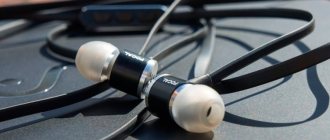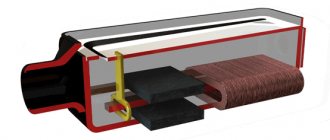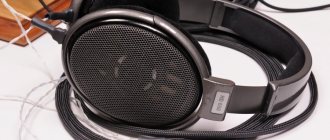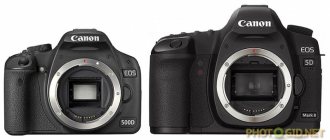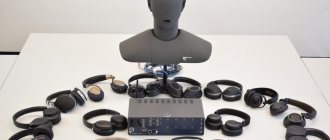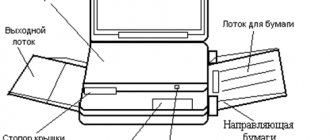How to choose the right headphones according to their parameters and what important characteristics to focus on so that the purchased device meets all your desires? After all, this accessory for listening to music differs in configuration, size, appearance and purpose.
The list of main requirements for headphones: sound quality and volume, noise insulation, sensitivity, power and design that suits the structure of the ear. In addition, the weight of the device and the presence of additional functions (for example, a built-in microphone) are important to buyers. The most important points are always indicated by the manufacturer on the packaging; all you have to do is learn to read them. This article will help you understand in detail the main 7 characteristics of headphones and tell you what parameters and how to choose this accessory.
Sensitivity
Directly related to the volume of music in the accessory. The parameter depends on the size of the magnetic core used in the headphone design and varies between 20 and 130 dB.
What does headphone sensitivity mean in dB? On the packaging it is defined as “dB/mW” or “dB/V” and shows the proportion between the volume level and power or voltage. Adjusting the sound on a portable device is a way to change its voltage. This suggests that the same headphones will sound differently at different MP3 player volumes. In addition, the number of decibels determines the energy efficiency of the headphones: the higher the sensitivity, the more economical the device’s battery consumption.
When deciding which sensitivity is better, you need to vote in favor of a device where its value will be at least 100 dB; with lower values, the sound will be very quiet, especially if you listen to music on the street. It is important to remember that prolonged listening to sounds louder than 80 dB can lead to fatigue and problems with the hearing organs.
How to choose headphones based on sensitivity? Today there are no strict standards by which manufacturers measure this parameter. Some take measurements at a frequency of 1 kHz, others reduce the indicators to 500 Hz, and still others generally take average results. The main thing that the average buyer should remember is: the higher the sensitivity level, the louder the accessory. This is provided that all other indicators are equal.
Determining what it is measured in
Headphone sensitivity is the maximum undistorted volume level.
It is measured in decibels (dB). Typically the gap is 90 - 120 dB. Moreover, most models have an even lower value - from 95 to 105 dB. It can be different for each device, so it is impossible to determine it exactly.
The quality of this characteristic also depends on the size of the magnetic core. The larger this part, the higher the indicator of the accessories. However, small in-ears, earbuds, and others are unlikely to have large cores. Therefore, they are of lower quality in this regard, compared to, for example, full-size ones.
The volume you hear through an accessory does not always depend on the smartphone itself. From one sound source through different gadgets, sound is perceived differently.
Resistance
How to choose the right headphones based on resistance (number of ohms)? Taking this criterion into account, all devices are divided into 2 types: low-resistance and high-resistance, while this gradation is different in large and small accessories. For “kids”, all accessories up to 32 Ohms are considered low-impedance, and those with a larger number are considered high-impedance. For large specimens - up to 100 Ohms and more than 100 Ohms, respectively.
The numbers in this parameter indicate the following:
- the lower the resistance, the higher the volume of the accessory, and vice versa;
- the higher the resistance value, the more economically the battery charge is consumed;
- The lower this parameter, the greater the acoustic potential the headphones have.
Of course, you shouldn’t rely only on this data, because they are directly related to other device parameters.
How to choose the resistance of headphones (impedance) when purchasing? If an accessory is purchased for a smartphone or other gadget, you must choose options with low numbers (16-40 Ohms). For a computer or TV, the ideal solution would be values in the range of 50-150 Ohms, which guarantees 100% purity of music and speech.
To clearly demonstrate the choice taking into account resistance and sensitivity, it would be correct to make a comparative table of 3 types of headphones. For example, the “budget” Philips SHE3595BK/00, the SONY MDR-XB450 AP device from the mid-price segment and the expensive ONKYO W800BTB/00 Mic accessory.
| Model | Sensitivity, dB | Resistance, Ohm | Frequency range, Hz |
| Philips SHE3595BK/00 | 102 | 16 | 10-23500 |
| SONY MDR-XB450 AP | 102 | 24 | 5-22000 |
| ONKYO W800BTB/00 | 107 | 16 | 6-22000 |
Interesting article on the topic: New Philips products for sports and active
What should be the sensitivity of headphones?
In general, the sensitivity of headphones is determined by the sound pressure they produce, measured in decibels. This is done after supplying an electrical signal of one megawatt. An indicator of 0 decibels is the sensitivity threshold of the human ear, and 140 decibels is its pain threshold.
The model should be selected based on their further use. It is important to take into account not only this parameter, but also the resistance coefficient. For smartphones, players and tablets, models with a sensitivity of 90 decibels and a resistance of 16 ohms are suitable to ensure sufficient volume with low signal power entering the device.
Attention! If the headphones are intended “for the street,” then it is better to take models from 100 decibels, otherwise the sound will be very quiet.
To connect the model to a head monitor and sound card without special amplifiers, you should take more sensitive models from 100 decibels and an impedance of more than 150 Ohms. Thanks to the high value of the latter indicator, distortion can be reduced and sound quality improved.
frequency range
On the headphone box, as a rule, the standard frequency is indicated: 20 Hz-20 kHz. These parameters determine whether the user can hear a sound of a certain frequency through the accessory. So what is the value of the property and how to choose headphones based on the frequency range?
Schematically, the proportion between loudness and frequency is drawn by a graph called amplitude-frequency response (AFC). A perfectly straight line on it means the same sound. By indicating frequency numbers, the manufacturer essentially describes the length of this straight line. But the specific requirements for the characteristics are not specified in any standard.
What does the buyer need to remember and what frequency should the headphones be? Here are 3 main rules:
- You should not choose an accessory based only on frequency parameters. These numbers will only help filter out the most inappropriate options.
- When purchasing, you must take into account that the specified range is still within the range of 20 Hz-20000 Hz.
- To determine the sound character of headphones, it is better to test their capabilities live.
You should be especially careful when purchasing copies whose frequency range is very different from the standard one. Many people know that humans cannot hear high notes with a frequency of more than 25 kHz (but dolphins will), which means that this characteristic is most likely just a marketing ploy.
Frequency response curve
This is the same amplitude-frequency characteristic that was already mentioned above. It depicts the tonal balance of sounds, breaking them down into different frequencies.
To understand the issue in more detail, you need to look at the figure on the left. The graph shows the frequencies and meaning of each range. Vertical - volume level. Its value is measured in decibels; doubling the sound is equal to 6 dB on the graph.
A perfectly clear sound, without hissing or hoarseness, occurs with a line that is as close as possible to a flat line. Manufacturers make such measurements based on the SPL (sound pressure) level, and you can view the measurement results on the official websites of the brand. To navigate the schedule, it is worth considering several examples at once.
Graph on the left. Shown here are the frequency response curves for large headphones like the SONY MDR-ZX330BT.
You can read about other brand headphones in the article: New SONY MDR-EX150, MDR-EX150AP and MDR-ZX660AP headphones: bright design, powerful sound
The lines in the figure mean:
- Green is a subjective frequency response, from which measurements are based.
- Yellow is an accessory preferred by lovers of live music. In recordings of such sounds, as a rule, there are no sharp frequency fluctuations.
- Blue - professional headphones for singers and musicians, in which the emphasis is on the high frequencies. In such a device, vocals can be heard especially clearly.
- Orange - headphones in which sibilants (vowel whistling sounds) are muffled.
Next up is the picture on the right. It shows the frequency variations for in-ear headphones or earbuds (such as the Philips SHB5250BK/00). What does it show?
The green curve has the same purpose as in the previous graph. And then:
- Orange line - illustrates equipment with high output at lower frequencies. This is a good option for smartphones and other devices.
- The blue line, on the contrary, shows the headphones where the high frequencies are especially prominent. Such equipment is intended for musicians, since the voice here is heard more clearly than the music.
To focus on such indicators, you must first decide on the purpose of purchasing headphones. It is also worth considering that the price depends on the quality of the equipment.
Driver Diaphragm Diameter
This indicator in headphones directly affects the sound quality. It is logical that the larger the speaker, the louder and clearer the sound, especially the “low bass”.
If you choose small “droplets” or other headphones of a similar design, then the membrane dimensions will range from 9 to 12 mm, which clearly does not guarantee the reproduction of high-quality lows.
The “strongest” headphones in this regard are full-size ones. The diameter of their speakers is often more than 30 mm. It is with this membrane size that you can achieve ideal depth, clarity and richness of sound. And why all? The larger the membrane, the easier it is to improve it. Manufacturers install various “chips”, improved magnets, etc. inside the body of such headphones, which ultimately help develop “deep” sound.
It will be interesting to know: TOP 10 best full-size closed headphones
Headphone impedance
Resistance (impedance) – nominal resistance at the headphone input. Quite a significant parameter. The most interesting thing is that for some reason many people use it to determine the volume of their headphones. Which is not entirely true. Volume is more affected by sensitivity. Resistance, of course, too, but not in the first place.
You can set approximate limits: resistance up to 100 Ohms - headphones for portable use. Everything above is for stationary. Portable sources usually do not have the ability to produce high voltage; therefore, low resistance is desirable here. But stationary amplifiers are quite capable of delivering any voltage, so high-impedance headphones are recommended for them.
Headphone impedance, which is better?
- If you are choosing a model for a phone or a simple player, the impedance of the headphones for the phone is not higher than 32 Ohms.
- If you have a good portable player or amplifier, then you can consider “tighter” models, but, again, you should not consider anything higher than 100 Ohms.
- In other cases (stationary models), it is important to match the resistance with the power of the amplifier. Not every stationary amplifier will “pull” 600 Ohms, at least qualitatively.
- But you shouldn’t rely only on resistance (“in a vacuum”). Sensitivity must also be taken into account. And the amplifier power is ideal.
For example, the vintage 600-Ohm beyerdynamic DT990 sounds quite good (and even quite loud) from my portable player. But I know very well that this is not all that they are capable of. For full disclosure not only in volume, but also in quality, you need a good stationary amplifier.
- TOP 10: Best studio headphones
- TOP 10: Best monitor headphones – studio under 100$
Headphone power
The volume of the sound will depend on this indicator, but the choice here is rather based on the technology to which they are connected. When paying attention to this parameter, it is worth considering several points:
- what this characteristic defines;
- what is measured and what power is better to choose headphones.
So, the accessory has two powers: the maximum input power, which indicates that this device can be connected to equipment with the same performance, and the nominal one. It, on the contrary, indicates the size of the signal that the headphones need to reach their peak performance.
The power that the headphones are designed for varies from 1 mW to 5000 mW. If the main goal is to purchase an accessory for a smartphone or tablet, then you should not focus on power. It is enough to take into account the sensitivity parameters so that the music plays loudly without overloading the battery.
Important characteristics and parameters of headphones
See what the headphones are made of:
The choice of suitable headphones depends, first of all, on what they are used for - talking on the phone, Skype or listening to music? A model equipped with a microphone is usually perfect for all situations. The only difference is that for conversation, especially over the Internet (VoIP), simple options are sufficient, if only because of audio compression. More important is the sound quality, the maximum available volume.
A model for music lovers must meet much greater requirements. See what options you need to check if you are looking for really good wired or wireless headphones.
Headphone sensitivity
See examples of sound volume levels:
In headphones, music volume is very important, that is, the sound pressure level. In other words - sensitivity. It is indicated in decibels (db). In accordance with EU regulations, the recommended maximum value is up to 85 dB, outside the EU the norm can reach up to 96 dB.
Most commercially available headphone models, however, have a higher maximum volume. But this also means higher blood pressure, which is felt over time. Listening to sounds louder than 80 dB for long periods of time can be tiring. The pain threshold is a volume level of 110-140 dB, and if these values are exceeded, hearing damage occurs.
If at any point you feel your hearing straining, turn off the music or take a break from listening. If you use good quality headphones, this should not happen. Remember also that the final volume of the headphones also depends on the volume of the output device and the quality of the connection between it and the headphones, as well as impedance.
Headphone impedance
Most mobile devices support values in the range of 16-64 ohms (denoted by the Greek letter Ω - omega). The higher the impedance, the more power you must provide to the headphones in order for them to reach a sufficient volume level.
This means that when connecting the same source that provides a lower current (for example, a smartphone), lower impedance headphones will be louder. On the other hand, the lower the resistance, the greater the susceptibility to noise.
Headphone frequency range
Pay attention to the frequency range, that is, low and high frequencies are supported. In the case of really good headphones, the range should be from 16 to 20,000 Hz - exactly the same as the range of sound perception in humans. The lower limit means the lowest, bass sounds, the upper range means high, i.e. top and any accents.
Remember, however, that manufacturers measure frequency range differently as there are no uniform requirements, and this can make a big difference. If your headphones are quiet at low frequencies, you may not actually hear the most bass sounds. Therefore, frequencies are an important criterion, but not the main one.
Headphone diaphragm size
An important feature that determines sound quality. Of course, the membrane of on-ear headphones is larger than that of in-ear and over-the-ear headphones. This is important so that the reproduced sound is less distorted and sounds better (especially low, bass tones).
Headphone membranes are made from various materials - artificial, paper, aluminum or titanium. High-quality headphones, with a wide range of operating frequencies, can be equipped with a microfiber membrane, which provides better sound.
Adjustable and comfortable
Comfort and ergonomics are also very important. The comfortable headphones are virtually undetectable, allowing you to listen to music for hours. If you buy in-ear or intrathecal headphones, you will usually receive a full set of ear tips and/or hooks in different sizes to fit the shape of your ear.
In the case of over-ear headphones, consider first of all the adjustment range of the earpiece.
Harmonic Distortion Factor
This property tells about the purity and clarity of the sound in the headphones. Measured as a percentage. For a good device, the coefficient does not exceed 0.5%; equipment with the highest indicators is already classified as mediocre.
While focusing on these parameters, it is also worth considering the frequency range at which the measurements were made. Thus, for low-frequency sounds the distortion rate reaches 10%, for high-frequency sounds (from 100 Hz) - 1% or less. Having read this characteristic on the packaging, you can only roughly judge the sound quality, but to be sure of this parameter, you need to listen to the headphones.
In addition, poor-quality (dull) sound in the device may occur during operation or due to breakdown. Why do headphones distort the sound? In most cases this happens due to:
- Bad wire contacts - this problem occurs in the headphone jack, which is the weakest part of the design. Especially if you regularly use the accessory during sports activities and trips, putting the player (or other device) in your pocket. Thus, a large level of load falls on the jack and the wires inside it, causing the wire to fray. The solution to the problem is to replace the jack or buy new headphones.
- Broken wire inside the device - a “afterlife” voice from the headphones can also appear if the wire is broken, which leads to the speaker. It is difficult to notice this defect, since the headphone cable is thin. Even after feeling its entire length, you may not understand where the gap is. When repairing, it is necessary to replace the entire cable.
- Water getting into the earphone - when walking with the accessory in the rain or snow, you need to be prepared for moisture getting into the inside of the device. If the headphones are not dried immediately, the water will oxidize the “insides”. You can dry the headphones near the battery (placing them on top is not recommended) or by leaving them in a jar with rice for a couple of hours, which will draw out the moisture.
- Damage to the jack for connecting equipment - another reason for distortion and poor sound in headphones can be an unsuitable jack or damaged contacts in it. The latter occurs if you often pull the jack back and forth from the socket. In case of such a breakdown, you need to contact a service center for help.
It is worth correcting these problems if they appeared on headphones that were already in use. When a dull sound, distortion or “trumpet” effect occurs with a new device, it is definitely not worth purchasing such an accessory.
Headphone sensitivity, impedance and frequency range - what is it?
Headphones are one of the most commonly used accessories used with various gadgets and electronic equipment, be it smartphones, computers, TVs, etc. every day. The average buyer usually focuses on two main factors when purchasing headphones - brand and budget.
But is this enough for a pleasant listening experience?
In this article, we will discuss three very important factors that buyers most often do not pay attention to - sensitivity, impedance and frequency range of headphones.
We hope this short article will provide you with detailed answers to these important questions.



